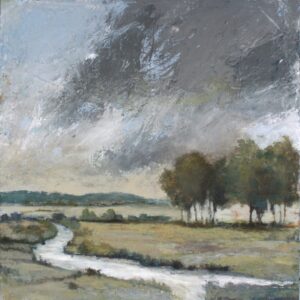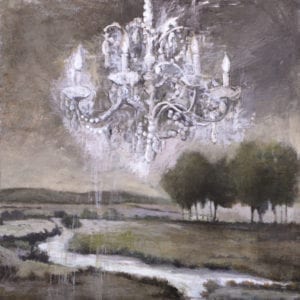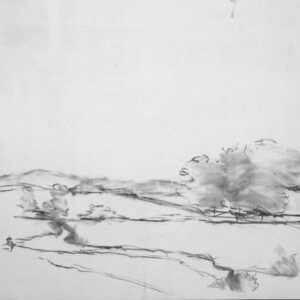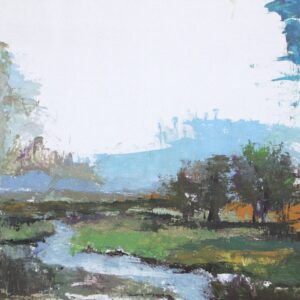Just Start!

Final layer of acrylic paint and oil on birch panel, 36″ x 36″, “Encroachment #3” by Rachael McCampbell
This article was published in the October 2016 issue of Nashville Arts Magazine.
by Rachael McCampbell
I wish I could have a dollar for every time someone has said to me, “I can’t draw or paint.” I’d be rich! I don’t believe there is any truth to this statement, because most anyone can apply paint to a surface, but what is true is that a great many people don’t have the patience to paint. I have witnessed it time and time again. It’s like the child who whines in the back of the car on a road trip, “Are we there yet?” With the constant checking of the clock and odometer, stress levels rise and the journey becomes unbearable—no one can focus on the joy of traveling. It’s the same with art. My students often want to be at the end of the process before they have even committed an hour to it. They toss their brushes down and state, “I’m not good at this—I give up.”
I understand this feeling because I fight the same instinct daily. If my work doesn’t manifest in the way I envisioned it, then I want to toss it in the trash and indulge in a massive pity party, but I don’t. Because after years of this, I finally learned that the challenge of remaining present and embracing the process (no matter how painful it is) improves not only my art but my whole existence. By turning the painting against the wall for a few days and giving us both a break, I come back with a new vision and attitude. I listen to what the painting wants to say, and I begin again.
I have noticed that the most difficult part of making art is rarely about the art. What comes up while making art can be a microcosm of what you are challenged by in your life. I have dried numerous tears of students whose impatience with painting turned out to be the sideways manifestation of other frustrations at home—lack of control over children and family, fears about an imminent career change or marital problems. To acknowledge our problems and funnel that energy into our art can be both therapeutic and create amazing results if we embrace it. But to get from a blank canvas to something we feel good about requires slowing down, going within, and observing both ourselves and the world around us. Being slow and intentional in our society is rarely honored. It’s much easier to stay busy and avoid all this, but then we would miss out on the joys and challenges of personal growth.
But to get from a blank canvas to something we feel good about requires slowing down, going within, and observing both ourselves and the world around us. Being slow and intentional in our society is rarely honored. It’s much easier to stay busy and avoid all this, but then we would miss out on the joys and challenges of personal growth.
So, to test your patience and yourself, pick up a brush or pencil and make some art. It doesn’t matter what you paint; just begin on your own or in a class. Make marks, lay down color, and feel the joy of creating something out of nothing, and suddenly you will experience your whole life there. And if you feel like giving up, go look in the mirror and ask why. It’s not always easy, but I guarantee that you will learn something. You will grow and you will like yourself more for trying.

Addition of chandelier in acrylic paint on birch panel, 36″ x 36″, “Encroachment #3” by Rachael McCampbell
Note: These images represent my process in creating a painting about my feelings on the encroachment of our wide-open spaces by developers. The chandeliers represent the opulence, waste, and disregard for what is truly important about nature. I began in charcoal, moved to acrylic, and finished in oil.

Final layer of acrylic paint and oil on birch panel, 36″ x 36″, “Encroachment #3” by Rachael McCampbell


